Input interpretation

10-(4-methylpiperazino)-10, 11-dihydrodibenzo(b, f)selenepin maleate
Basic properties
![molar mass | 473.4 g/mol formula | C_23H_26N_2O_4Se empirical formula | C_23O_4N_2Se_H_26 SMILES identifier | CN1CCN(CC1)C2CC3=CC=CC=C3[Se]C4=CC=CC=C24.C(=C/C(=O)O)/C(=O)O InChI identifier | InChI=1/C19H22N2Se.C4H4O4/c1-20-10-12-21(13-11-20)17-14-15-6-2-4-8-18(15)22-19-9-5-3-7-16(17)19;5-3(6)1-2-4(7)8/h2-9, 17H, 10-14H2, 1H3;1-2H, (H, 5, 6)(H, 7, 8)/b;2-1-/f/h;5, 7H InChI key | BDFIJNCOFFEWEX-BTJKTKAUSA-N](../image_source/05ca782e5e396b57c6bf1afd04046e92.png)
molar mass | 473.4 g/mol formula | C_23H_26N_2O_4Se empirical formula | C_23O_4N_2Se_H_26 SMILES identifier | CN1CCN(CC1)C2CC3=CC=CC=C3[Se]C4=CC=CC=C24.C(=C/C(=O)O)/C(=O)O InChI identifier | InChI=1/C19H22N2Se.C4H4O4/c1-20-10-12-21(13-11-20)17-14-15-6-2-4-8-18(15)22-19-9-5-3-7-16(17)19;5-3(6)1-2-4(7)8/h2-9, 17H, 10-14H2, 1H3;1-2H, (H, 5, 6)(H, 7, 8)/b;2-1-/f/h;5, 7H InChI key | BDFIJNCOFFEWEX-BTJKTKAUSA-N
Structure diagram
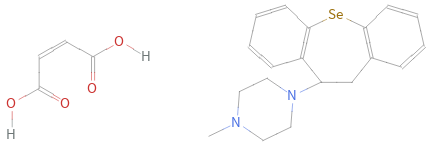
Structure diagram
Quantitative molecular descriptors
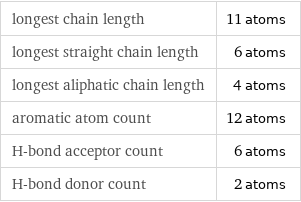
longest chain length | 11 atoms longest straight chain length | 6 atoms longest aliphatic chain length | 4 atoms aromatic atom count | 12 atoms H-bond acceptor count | 6 atoms H-bond donor count | 2 atoms
Elemental composition

Find the elemental composition for 10-(4-methylpiperazino)-10, 11-dihydrodibenzo(b, f)selenepin maleate in terms of the atom and mass percents: atom percent = N_i/N_atoms × 100% mass percent = (N_im_i)/m × 100% Plan: • Write the chemical formula and gather atomic masses from the periodic table. • Determine values for N_i, m_i, N_atoms and m using these items. • Finally, compute the percents and check the results. Write the chemical formula: C_23H_26N_2O_4Se Use the chemical formula to count the number of atoms, N_i, for each element and find the total number of atoms, N_atoms, per molecule: | number of atoms C (carbon) | 23 O (oxygen) | 4 N (nitrogen) | 2 Se (selenium) | 1 H (hydrogen) | 26 N_atoms = 23 + 4 + 2 + 1 + 26 = 56 Divide each N_i by N_atoms to calculate atom fractions. Then use the property that atom fractions must sum to one to check the work: | number of atoms | atom fraction C (carbon) | 23 | 23/56 O (oxygen) | 4 | 4/56 N (nitrogen) | 2 | 2/56 Se (selenium) | 1 | 1/56 H (hydrogen) | 26 | 26/56 Check: 23/56 + 4/56 + 2/56 + 1/56 + 26/56 = 1 Compute atom percents using the atom fractions: | number of atoms | atom percent C (carbon) | 23 | 23/56 × 100% = 41.1% O (oxygen) | 4 | 4/56 × 100% = 7.14% N (nitrogen) | 2 | 2/56 × 100% = 3.57% Se (selenium) | 1 | 1/56 × 100% = 1.79% H (hydrogen) | 26 | 26/56 × 100% = 46.4% Look up the atomic mass, m_i, in unified atomic mass units, u, for each element in the periodic table: | number of atoms | atom percent | atomic mass/u C (carbon) | 23 | 41.1% | 12.011 O (oxygen) | 4 | 7.14% | 15.999 N (nitrogen) | 2 | 3.57% | 14.007 Se (selenium) | 1 | 1.79% | 78.971 H (hydrogen) | 26 | 46.4% | 1.008 Multiply N_i by m_i to compute the mass for each element. Then sum those values to compute the molecular mass, m: | number of atoms | atom percent | atomic mass/u | mass/u C (carbon) | 23 | 41.1% | 12.011 | 23 × 12.011 = 276.253 O (oxygen) | 4 | 7.14% | 15.999 | 4 × 15.999 = 63.996 N (nitrogen) | 2 | 3.57% | 14.007 | 2 × 14.007 = 28.014 Se (selenium) | 1 | 1.79% | 78.971 | 1 × 78.971 = 78.971 H (hydrogen) | 26 | 46.4% | 1.008 | 26 × 1.008 = 26.208 m = 276.253 u + 63.996 u + 28.014 u + 78.971 u + 26.208 u = 473.442 u Divide the mass for each element by m to calculate mass fractions. Then use the property that mass fractions must sum to one to check the work: | number of atoms | atom percent | mass fraction C (carbon) | 23 | 41.1% | 276.253/473.442 O (oxygen) | 4 | 7.14% | 63.996/473.442 N (nitrogen) | 2 | 3.57% | 28.014/473.442 Se (selenium) | 1 | 1.79% | 78.971/473.442 H (hydrogen) | 26 | 46.4% | 26.208/473.442 Check: 276.253/473.442 + 63.996/473.442 + 28.014/473.442 + 78.971/473.442 + 26.208/473.442 = 1 Compute mass percents using the mass fractions: Answer: | | | number of atoms | atom percent | mass percent C (carbon) | 23 | 41.1% | 276.253/473.442 × 100% = 58.35% O (oxygen) | 4 | 7.14% | 63.996/473.442 × 100% = 13.52% N (nitrogen) | 2 | 3.57% | 28.014/473.442 × 100% = 5.917% Se (selenium) | 1 | 1.79% | 78.971/473.442 × 100% = 16.68% H (hydrogen) | 26 | 46.4% | 26.208/473.442 × 100% = 5.536%
Elemental oxidation states

The first step in finding the oxidation states (or oxidation numbers) in 10-(4-methylpiperazino)-10, 11-dihydrodibenzo(b, f)selenepin maleate is to draw the structure diagram. Next set every oxidation number equal to the atom's formal charge: In 10-(4-methylpiperazino)-10, 11-dihydrodibenzo(b, f)selenepin maleate hydrogen is not bonded to a metal with lower electronegativity, so it will have an oxidation state of +1. Any element bonded to hydrogen gains the bonding electrons, decreasing their oxidation state by 1 for every bond: With hydrogen out of the way, look at the remaining bonds. There are 6 carbon-nitrogen bonds, 4 carbon-oxygen bonds, 2 carbon-selenium bonds, and 20 carbon-carbon bonds. For each of these bonds, assign the bonding electrons to the most electronegative element. First examine the carbon-nitrogen bonds: element | electronegativity (Pauling scale) | C | 2.55 | N | 3.04 | | | Since nitrogen is more electronegative than carbon, the electrons in these bonds will go to nitrogen. Decrease the oxidation number for nitrogen in every highlighted bond (by 1 for single bonds, 2 for double bonds, and 3 for triple bonds), and increase the oxidation number for carbon accordingly: Next look at the carbon-oxygen bonds: element | electronegativity (Pauling scale) | C | 2.55 | O | 3.44 | | | Since oxygen is more electronegative than carbon, the electrons in these bonds will go to oxygen: Next look at the carbon-selenium bonds: element | electronegativity (Pauling scale) | C | 2.55 | Se | 2.55 | | | Since selenium is more electronegative than carbon, the electrons in these bonds will go to selenium: Next look at the carbon-carbon bonds: element | electronegativity (Pauling scale) | C | 2.55 | C | 2.55 | | | Since these elements are the same the bonding electrons are shared equally, and there is no change to the oxidation states: Now summarize the results: Answer: | | oxidation state | element | count -3 | N (nitrogen) | 2 -2 | C (carbon) | 2 | O (oxygen) | 4 -1 | C (carbon) | 14 0 | C (carbon) | 5 | Se (selenium) | 1 +1 | H (hydrogen) | 26 +3 | C (carbon) | 2
Orbital hybridization
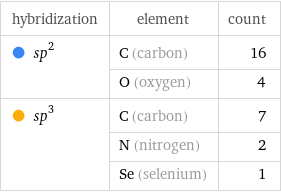
hybridization | element | count sp^2 | C (carbon) | 16 | O (oxygen) | 4 sp^3 | C (carbon) | 7 | N (nitrogen) | 2 | Se (selenium) | 1
Structure diagram
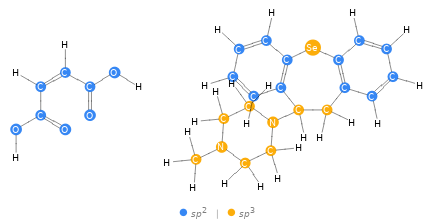
Orbital hybridization Structure diagram
Topological indices
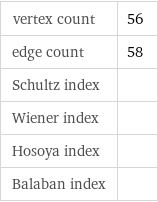
vertex count | 56 edge count | 58 Schultz index | Wiener index | Hosoya index | Balaban index |